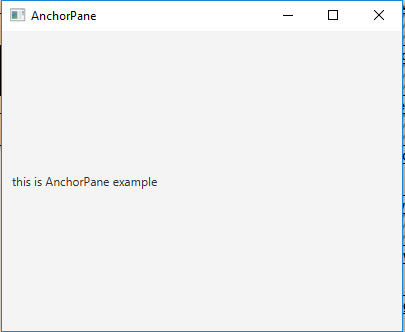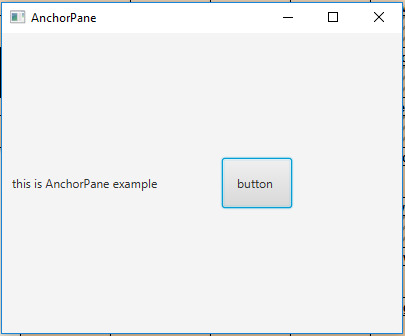AnchorPane 类是 JavaFX 的一部分。 AnchorPane 允许将子节点的边锚定到距锚窗格边的偏移处。如果锚窗格设置了边框和/或填充,则将从这些插图的内边测量偏移量。 AnchorPane 继承 Pane 类。
类的构造函数:
- AnchorPane():创建一个新的 AnchorPane。
- AnchorPane(Node… c):创建具有指定节点的 AnchorPane。
常用方法:
| 方法 | 解释 |
|---|---|
| getBottomAnchor(Node c) | 返回孩子的底部锚点。 |
| getLeftAnchor(Node c) | 返回孩子的左锚。 |
| getRightAnchor(Node c) | 返回孩子的右锚。 |
| getTopAnchor(Node c) | 返回孩子的顶部锚点。 |
| setBottomAnchor(Node c, Double v) | 设置孩子的底部锚点。 |
| setLeftAnchor(Node c, Double v) | 设置孩子的左锚。 |
| setRightAnchor(Node c, Double v) | 设置孩子的右锚。 |
| setTopAnchor(Node c, Double v) | 设置孩子的顶部锚点。 |
以下示例程序旨在说明 AnchorPane 类的使用:
- Java 程序创建一个 AnchorPane 并为其添加标签并将标签添加到阶段:在这个程序中,我们将创建一个名为 anchor_pane 的 AnchorPane。在 anchor_pane 中添加一个名为 label 的 Label,并分别使用 setTopAnchor()、setBottomAnchor()、setLeftAnchor()、setRightAnchor() 函数设置顶部、底部、左侧、右侧。现在将 anchor_pane 添加到场景中。然后最后把场景添加到舞台上,调用show()函数显示结果。
// Java Program to create a AnchorPane and // add label to it and add label to the // stage import javafx.application.Application; import javafx.scene.Scene; import javafx.scene.control.*; import javafx.scene.layout.*; import javafx.stage.Stage; import javafx.event.ActionEvent; import javafx.event.EventHandler; import javafx.scene.canvas.*; import javafx.scene.web.*; import javafx.scene.layout.AnchorPane; import javafx.scene.shape.*; public class AnchorPane_1 extends Application { // launch the application public void start(Stage stage) { try { // set title for the stage stage.setTitle("AnchorPane"); // create a label Label label = new Label("this is AnchorPane example"); // create a AnchorPane AnchorPane anchor_pane = new AnchorPane(label); // anchor to the label AnchorPane.setTopAnchor(label, 10.0); AnchorPane.setLeftAnchor(label, 10.0); AnchorPane.setRightAnchor(label, 10.0); AnchorPane.setBottomAnchor(label, 10.0); // create a scene Scene scene = new Scene(anchor_pane, 400, 300); // set the scene stage.setScene(scene); stage.show(); } catch (Exception e) { System.out.println(e.getMessage()); } } // Main Method public static void main(String args[]) { // launch the application launch(args); } }输出:

- 创建 AnchorPane 的 Java 程序,为其添加标签和按钮,并设置 AnchorPane 的最小高度和宽度,然后将其添加到舞台:在这个程序中,我们将创建一个名为 anchor_pane 的 AnchorPane。将一个名为 label 的标签添加到 anchor_pane。还添加一个名为 button 的 Button 并分别使用 setTopAnchor()、setBottomAnchor()、setLeftAnchor()、setRightAnchor() 函数设置顶部、底部、左侧、右侧锚点。使用 setMinHeight() 和 setMinWidth() 函数设置最小高度和宽度。将 anchor_pane 添加到场景中。最后,将场景添加到舞台并调用 show() 函数以显示结果。
// Java Program to create a AnchorPane, adding // label and button to it and also setting the // min height and width of AnchorPane then add // it to the stage import javafx.application.Application; import javafx.scene.Scene; import javafx.scene.control.*; import javafx.scene.layout.*; import javafx.stage.Stage; import javafx.event.ActionEvent; import javafx.event.EventHandler; import javafx.scene.canvas.*; import javafx.scene.web.*; import javafx.scene.layout.AnchorPane; import javafx.scene.shape.*; public class AnchorPane_2 extends Application { // launch the application public void start(Stage stage) { try { // set title for the stage stage.setTitle("AnchorPane"); // create a label Label label = new Label("this is AnchorPane example"); // create a AnchorPane AnchorPane anchor_pane = new AnchorPane(label); // anchor to the label AnchorPane.setTopAnchor(label, 120.0); AnchorPane.setLeftAnchor(label, 10.0); AnchorPane.setRightAnchor(label, 230.0); AnchorPane.setBottomAnchor(label, 120.0); Button button = new Button("button "); // anchor to the button AnchorPane.setTopAnchor(button, 125.0); AnchorPane.setLeftAnchor(button, 220.0); AnchorPane.setRightAnchor(button, 110.0); AnchorPane.setBottomAnchor(button, 125.0); anchor_pane.getChildren().add(button); anchor_pane.setMinHeight(400); anchor_pane.setMinWidth(400); // create a scene Scene scene = new Scene(anchor_pane, 400, 300); // set the scene stage.setScene(scene); stage.show(); } catch (Exception e) { System.out.println(e.getMessage()); } } // Main Method public static void main(String args[]) { // launch the application launch(args); } }输出:

注意:上述程序可能无法在在线 IDE 中运行,请使用离线编译器。
参考: https://docs.oracle.com/javase/8/javafx/api/javafx/scene/layout/AnchorPane.html
相关用法
- JavaFX 类 AmbientLight用法及代码示例
- JavaFX 类 TextFlow用法及代码示例
- JavaFX 类 Tab用法及代码示例
- JavaFX 类 HTMLEditor用法及代码示例
- JavaFX 类 Cursor用法及代码示例
- JavaFX 类 PieChart用法及代码示例
- JavaFX 类 Point3D用法及代码示例
- JavaFX 类 Shadow用法及代码示例
- JavaFX 类 Insets用法及代码示例
- JavaFX 类 Dimension2D用法及代码示例
- JavaFX 类 Point2D用法及代码示例
- JavaFX 类 Canvas用法及代码示例
- JavaFX 类 Reflection用法及代码示例
- JavaFX 类 DropShadow用法及代码示例
- JavaFX 类 ColorAdjust用法及代码示例
- JavaFX 类 InnerShadow用法及代码示例
- JavaFX 类 ColorInput用法及代码示例
- JavaFX 类 Rectangle2D用法及代码示例
注:本文由纯净天空筛选整理自andrew1234大神的英文原创作品 JavaFX | AnchorPane Class。非经特殊声明,原始代码版权归原作者所有,本译文未经允许或授权,请勿转载或复制。
